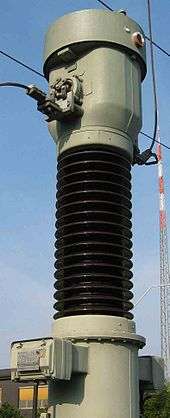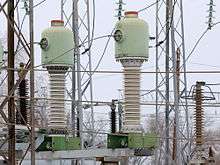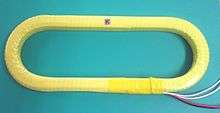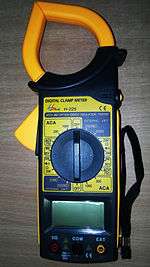Current transformer

A current transformer (CT) is a transformer that is used to produce an alternating current (AC) in its secondary which is proportional to the AC current in its primary. Current transformers, together with voltage transformers (VTs) or potential transformers (PTs), which are designed for measurement, are known as instrument transformers.
When a current is too high to measure directly or the voltage of the circuit is too high, a current transformer can be used to provide an isolated lower current in its secondary which is proportional to the current in the primary circuit. The induced secondary current is then suitable for measuring instruments or processing in electronic equipment. Current transformers also have little effect on the primary circuit. Often, in electronic equipment, the isolation between the primary and secondary circuit is the important characteristic.
Current transformers are used in electronic equipment and are widely used for metering and protective relays in the electrical power industry.
Function




Like any transformer, a current transformer has a primary winding, a core and a secondary winding, although some transformers, including current transformers, use an air core. In principle, the only difference between a current transformer and a voltage transformer (normal type) is that the former is fed with a 'constant' current while the latter is fed with a 'constant' voltage, where 'constant' has the strict circuit theory meaning.
The alternating current in the primary produces an alternating magnetic field in the core, which then induces an alternating current in the secondary. The primary circuit is largely unaffected by the insertion of the CT. Accurate current transformers need close coupling between the primary and secondary to ensure that the secondary current is proportional to the primary current over a wide current range. The current in the secondary is the current in the primary (assuming a single turn primary) divided by the number of turns of the secondary. In the illustration on the right, 'I' is the current in the primary, 'B' is the magnetic field, 'N' is the number of turns on the secondary, and 'A' is an AC ammeter.
Typically current transformers consist of a silicon steel ring core wound with many turns of copper wire as shown in the right illustration. The conductor carrying the primary current is then passed through the ring; the CT's primary therefore consists of a single 'turn'. The primary 'winding' may be a permanent part of the current transformer, with a heavy copper bar to carry current through the core. Window-type current transformers (aka zero sequence current transformers, or ZSCT) are also common, which can have circuit cables run through the middle of an opening in the core to provide a single-turn primary winding. To assist accuracy, the primary conductor should be central in aperture.
CTs are specified by their current ratio from primary to secondary. The rated secondary current is normally standardized at 1 or 5 amperes. For example, a 4000:5 CT secondary winding will supply an output current of 5 amperes when the primary winding current is 4000 amperes. This ratio can also be used to find the impedance or voltage on one side of the transformer, given the appropriate value at the other side. For the 4000:5 CT, the secondary impedance can be found as ZS = NZP = 800ZP, and the secondary voltage can be found as VS = NVP = 800VP. In some cases, the secondary impedance is referred to the primary side, and is found as ZS’ = N2ZP. Referring the impedance is done simply by multiplying initial secondary impedance value by the current ratio. The secondary winding of a CT can have taps to provide a range of ratios, five taps being common.
Shapes and sizes can vary depending on the end user or switch gear manufacturer. Low-voltage single ratio metering current transformers are either a ring type or plastic molded case.
Split-core current transformers either have a two-part core or a core with a removable section. This allows the transformer to be placed around a conductor with the minimum disturbance. Split-core current transformers are typically used in low current measuring instruments, often portable, battery-operated, and hand-held (see illustration lower right).
Use

Current transformers are used extensively for measuring current and monitoring the operation of the power grid. Along with voltage leads, revenue-grade CTs drive the electrical utility's watt-hour meter on virtually every building with three-phase service and single-phase services greater than 200 amperes.
High-voltage current transformers are mounted on porcelain or polymer insulators to isolate them from ground. Some CT configurations slip around the bushing of a high-voltage transformer or circuit breaker, which automatically centers the conductor inside the CT window.
Current transformers can be mounted on the low voltage or high voltage leads of a power transformer; sometimes a section of a bus-bar can be removed to replace a current transformer.
Often, multiple CTs are installed as a "stack" for various uses. For example, protection devices and revenue metering may use separate CTs to provide isolation between metering and protection circuits, and allows current transformers with different characteristics (accuracy, overload performance) to be used for the devices.
The burden (load) impedance should not exceed the specified maximum value to avoid the secondary voltage exceeding the limits for the current transformer. Also, the primary current rating of a current transformer should not be exceeded or the core may enter its non linear region and ultimately saturate. This would occur near the end of the first half of each half (positive and negative) of the AC sine wave in the primary and would compromise the accuracy.
Safety
Current transformers are often used to monitor hazardously high currents or currents at hazardously high voltages, so great care must be taken in the design and use of CTs in these situations.
The secondary of a current transformer should not be disconnected from its burden while current is in the primary, as the secondary will attempt to continue driving current into an effective infinite impedance up to its insulation break-down voltage and thus compromise operator safety. For certain current transformers this voltage may reach several kilo-volts and may even cause arcing. Exceeding the secondary voltage may also degrade the accuracy of the transformer or even destroy it. Energizing a current transformer with an open circuit secondary is the complement of energizing a voltage transformer (normal type) with a short circuit secondary. In the first case the secondary tries to produce an infinite voltage and in the second case the secondary tries to produce an infinite current. Both scenarios can be dangerous and damage the transformer.
Accuracy
The accuracy of a CT is affected by a number of factors including:
- Burden
- Burden class/saturation class
- Rating factor
- Load
- External electromagnetic fields
- Temperature
- Physical configuration
- The selected tap, for multi-ratio CTs
- Phase change
- Capacitive coupling between primary and secondary
- Resistance of primary and secondary
- Core magnetizing current
For the IEC standard, accuracy classes for various types of measurement are set out in IEC 61869-1, Classes 0.1, 0.2s, 0.2, 0.5, 0.5s, 1 and 3. The class designation is an approximate measure of the CT's accuracy. The ratio (primary to secondary current) error of a Class 1 CT is 1% at rated current; the ratio error of a Class 0.5 CT is 0.5% or less. Errors in phase are also important especially in power measuring circuits, and each class has an allowable maximum phase error for a specified load impedance.
Current transformers used for protective relaying also have accuracy requirements at overload currents in excess of the normal rating to ensure accurate performance of relays during system faults. A CT with a rating of 2.5L400 specifies with an output from its secondary winding of 20 times its rated secondary current (usually 5 A × 20 = 100 A) and 400 V (IZ drop) its output accuracy will be within 2.5 percent.
Burden
The secondary load of a current transformer is termed the "burden" to distinguish it from the primary load.
The burden in a CT metering circuit is the largely resistive impedance presented to its secondary winding. Typical burden ratings for IEC CTs are 1.5 VA, 3 VA, 5 VA, 10 VA, 15 VA, 20 VA, 30 VA, 45 VA and 60 VA. ANSI/IEEE burden ratings are B-0.1, B-0.2, B-0.5, B-1.0, B-2.0 and B-4.0. This means a CT with a burden rating of B-0.2 can tolerate an impedance of up to 0.2 Ω on the secondary circuit before its accuracy falls outside of its specification. These specification diagrams show accuracy parallelograms on a grid incorporating magnitude and phase angle error scales at the CT's rated burden. Items that contribute to the burden of a current measurement circuit are switch-blocks, meters and intermediate conductors. The most common cause of excess burden impedance is the conductor between the meter and the CT. When substation meters are located far from the meter cabinets, the excessive length of cable creates a large resistance. This problem can be reduced by using thicker cables and CTs with lower secondary currents (1A), both of which will produce less voltage drop between the CT and its metering devices.
Knee-point core-saturation voltage
The knee-point voltage of a current transformer is the magnitude of the secondary voltage above which the output current ceases to linearly follow the input current within declared accuracy. In testing, if a voltage is applied across the secondary terminals the magnetizing current will increase in proportion to the applied voltage, until the knee point is reached. The knee point is defined as the voltage at which a 10% increase in applied voltage increases the magnetizing current by 50%. For voltages greater than the knee point, the magnetizing current increases considerably even for small increments in voltage across the secondary terminals. The knee-point voltage is less applicable for metering current transformers as their accuracy is generally much higher, but constrained within a very small range of the current transformer rating, typically 1.2 to 1.5 times rated current. However, the concept of knee point voltage is very pertinent to protection current transformers, since they are necessarily exposed to fault currents of 20 to 30 times rated current.[1]
Phase shift
Ideally, the primary and secondary currents of a current transformer should be in phase. In practice, this is impossible, but, at normal power frequencies, phase shifts of a few tenths of a degree are achievable, while simpler CTs may have phase shifts up to six degrees.[2] For current measurement, phase shift is immaterial as ammeters only display the magnitude of the current. However, in wattmeters, energy meters, and power factor meters, phase shift produces errors. For power and energy measurement, the errors are considered to be negligible at unity power factor but become more significant as the power factor approaches zero. At zero power factor, all the measured power is due to the current transformer's phase error.[2] The introduction of electronic power and energy meters has allowed current phase error to be calibrated out.[3]
Special types
Specially constructed wideband current transformers are also used (usually with an oscilloscope) to measure waveforms of high frequency or pulsed currents within pulsed power systems. Unlike CTs used for power circuitry, wideband CTs are rated in output volts per ampere of primary current.
If the burden resistance is much less than inductive impedance of the secondary winding at the measurement frequency then the current in the secondary tracks the primary current and the transformer provides a current output that is proportional to the measured current. On the other hand, if that condition is not true, then the transformer is inductive and gives a differential output. The Rogowski coil uses this effect and requires an external integrator in order to provide a voltage output that is proportional to the measured current.
Standards
Ultimately, depending on client requirements, there are two main standards to which current transformers are designed. IEC 61869-1 (in the past IEC 60044-1) & IEEE C57.13 (ANSI), although the Canadian and Australian standards are also recognised.
High voltage types
Current transformers are used for protection, measurement and control in high-voltage electrical substations and the electrical grid. Current transformers may be installed inside switchgear or in apparatus bushings, but very often free-standing outdoor current transformers are used. In a switchyard, live tank current transformers have a substantial part of their enclosure energized at the line voltage and must be mounted on insulators. Dead tank current transformers isolate the measured circuit from the enclosure. Live tank CTs are useful because the primary conductor is short, which gives better stability and a higher short-circuit current rating. The primary of the winding can be evenly distributed around the magnetic core, which gives better performance for overloads and transients. Since the major insulation of a live-tank current transformer is not exposed to the heat of the primary conductors, insulation life and thermal stability is improved.
A high-voltage current transformer may contain several cores, each with a secondary winding, for different purposes (such as metering circuits, control, or protection).[4] A neutral current transformer is used as earth fault protection to measure any fault current flowing through the neutral line from the wye neutral point of a transformer.
See also
References
- Guile, A.; Paterson, W. (1977). Electrical Power Systems, Volume One. Pergamon. p. 331. ISBN 0-08-021729-X.
- ↑ Anon, Protective Relays Application Guide Second Edition, The General Electric Company Limited of England, 1975 Section 5.3
- 1 2 http://www.ccontrolsys.com/w/Measurement_Errors_Due_to_CT_Phase_Shift
- ↑ http://www.ccontrolsys.com/w/CT_Phase_Angle_Correction
- ↑ Protective Relays Application Guide, (The General Electric Company Limited of England, 1975) pages 78-87
External links
| Wikimedia Commons has media related to Current transformers. |